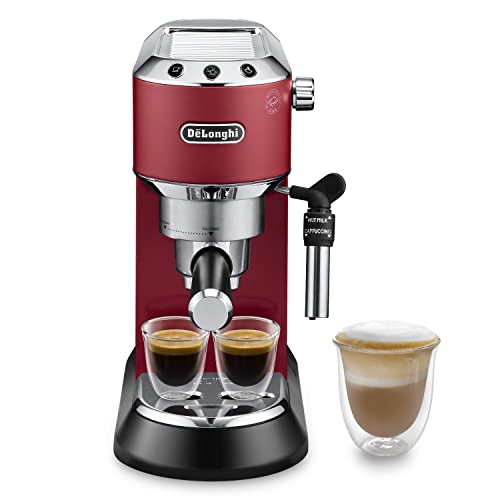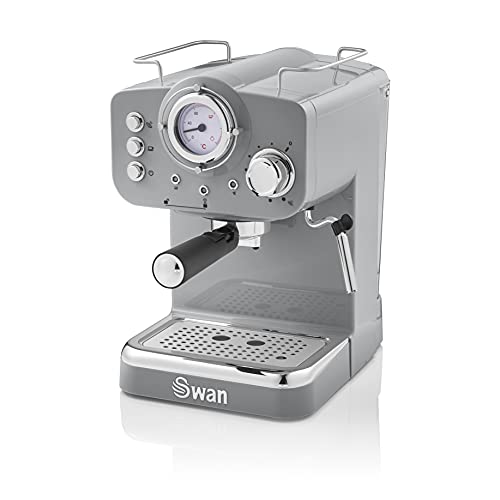9 . What Your Parents Taught You About Barista Espresso Machine
페이지 정보
작성자 Leland 작성일 25-02-02 04:16 조회 8 댓글 0본문
 What to Look For in a Barista Espresso Machine
What to Look For in a Barista Espresso MachineThe espresso machine is one of the most intricate coffee machines available. It is comprised of three main parts. The base holds the water and the middle is a filter-basket with a filter made of metal.
This machine was a major success and was instrumental in bringing home barista espresso. Features include a 2.2L steam boiler, a low pressure pre-infusion & 9 bar brewing pressure.
Pressure
If you're a coffee lover, you'll be aware that the pressure of your espresso machine is a major element in the quality of your drinks. The pressure of your machine is crucial to making excellent coffee, whether you're seeking a thick layer or a perfect balance of acidity and flavor.
BARs (Barometric pressure) is the force your espresso machine with milk frother machine applies to the grounds of your coffee while delivering high-pressure water. 9 BARs mean that your espresso machine is pushing heated water through the coffee grounds at a rate of nine times the Earth's current atmospheric pressure.
The pressure of your espresso machine is important because it's what allows the water to flow through the grounds of coffee at the proper speed and with the right intensity. If the pressure is too low the dissolved oils and flavors won't be extracted properly. If the pressure is too low the flavors and oils that are dissolved won't be extracted properly.
The pressure of your espresso machine can be controlled by adjusting the screw on the espresso pump. Commercial machines as well as some high-end home appliances have pumps with rotary that can be adjusted. For the cheaper home machines that have a vibrating motor, it is impossible to alter the pressure without hacks. Companies like Cafflano however, are working on technology that uses Pascal's Principle to ensure pressure in the portafilter during the brewing process.
Temperature
Temperature is among the most crucial factors in a great small espresso machine shot. The water that is too hot can scorch the grounds of coffee, which can result in a bitter espresso. The ideal temperature for extraction is 200 degrees Fahrenheit. This lets the water to extract all the desired coffee flavors without burning the grounds or over-extracting.
The best Espresso Machine espresso machines will have a thermoblock or Best Espresso Machine thermocoil that is used to heat the water and keep it at a steady temperature throughout the whole extraction process. The Breville Barista Express, for instance, comes with PID (Proportional Integral Derivative) system that constantly monitors the temperature of water and adjusts it as needed making sure that the brewhead stays at the right temperature to extract the coffee.
Most coffee lovers are aware that the temperature of an espresso machine is vital to brewing a great cup of coffee. The ideal temperature for espresso is between Fahrenheit between 190-196. To achieve this, you require an espresso maker with a reliable thermoblock, thermocoil or thermoblock and a boiler that is appropriately sized.
In addition, it is important to pre-heat your portafilter, machine, and cup prior to taking an espresso. A failure to warm your espresso maker is one of the most frequent mistakes that can be made by novice espresso makers. This is why you should always read the instruction manual before making use of your espresso maker for the first time.
Grind
A barista espresso machine must provide a variety grind settings to give you the greatest control over the final cup of coffee. Some machines come with an analog gauge that looks cool and can help you improve your brewing abilities. Ideally, you should get around nine bars of pressure and keep that throughout the brew cycle. Although this machine isn't hitting the mark, it's close enough and will serve you well.
A built-in burr mill is a excellent feature. This is a fantastic feature for people who are new to espresso since it doesn't require them to buy a separate burr grinder. The stainless steel conical grinder features 18 settings, which range from "coarse to fine."
The grinder isn't as effective as a stand-alone device, but it can get you to the right path to making excellent espresso shots. It's easy to clean, and you can pause the grinder during the grinding process to prevent accumulating a large amount of ground in your portafilter when it is being stamped.
This is a stunning and practical machine that lets you to experience the joy of becoming a barista from home. It's a great option for anyone who wants to to look back at the memories of pouring microfoam into their morning coffee, locking a portafilter into the grouphead, and tamping with precision. A bean-to-cup machine is a great choice for those who are looking for convenience.
Water
Water can be a difficult thing to master. Finding the right balance is crucial. Too much caffeine can cause mineral deposits to form in your machine, but too little and you'll struggle to get a rich cup of espresso.
The ideal water for espresso has an alkalinity and hardness that is low level. This is best small espresso machine achieved by using an effective water filtering system that does away with chlorine and then adds an amount of total dissolved solids (TDS) to add some calcium and magnesium to the mix. This will give you a good balance between acidity and hardness, and prevent the necessity of decalcifying.
It is crucial to make sure you use water that has been filtered to a good quality to ensure the health and flavor of your machine. Descaling products must be regularly used depending on the hardness and use of your machine. These products are available in liquid, powder or tab form at the majority of hardware stores.
The Breville Barista Express, a premium espresso machine for home use is designed to bring the café experience to your home. It is more sophisticated than other machines for beginners which are targeted at coffee lovers who want to refine their techniques and perfect their craft. The thermocoil heater that has an integrated PID controller placed on the group head which is constantly heated and allows you to control your brewing temperature. This can be a huge advantage over the other models which require more time "temperature surfing" to get a consistent espresso.

- 이전글 10 Things Everybody Has To Say About Patio Doors Repairs Near Me Patio Doors Repairs Near Me
- 다음글 Free Evolution Explained In Fewer Than 140 Characters
댓글목록 0
등록된 댓글이 없습니다.
